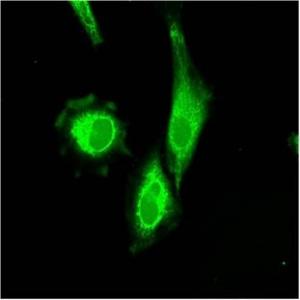World's first successful visualisation of key coenzyme

Fluorescent imaging of HeLa cell Copyright : National Institute for Materials Science (NIMS)
A Japanese research team led by Drs. Hirokazu Komatsu and Katsuhiko Ariga of the International Center for Materials Nanoarchitectonics, in collaboration with Professors Yutaka Shido and Kotaro Oka of Keio University, have developed the world's first method for visualising the coenzyme nicotine-adenine dinucleotide derivative (NAD(P)H) inside cells.
Fluorescent imaging – used to identify and visualise cellular components by attaching a fluorescent substance – is an effective method for exploring vital phenomena.
Until now, however, the development of a method for visualising NAD(P)H, which plays a key role in various vital phenomena and diseases, has proven elusive due to the low reactivity of NAD(P)H to fluorescent substances.
The research group succeeded in developing a new fluorescent probe that specifically reacts with NAD(P)H, and achieved fluorescent imaging of NAD(P)H for the first time in the world, through the combined use of the new probe and an artificial promoter capable of promoting reactivity.
The new NADH imaging method could be used for various purposes, including: promoting early detection and supporting cancer treatment by detecting NADH leakage from invasive cancers; diagnosing liver dysfunction by detecting excessive NADH caused by cirrhosis of the liver; and elucidating the lack of NADH in patients with brain or neurological diseases such as Alzheimer's Disease, depression, and Parkinson's Disease.
The new method will also prove of great value in other life sciences research.
The research results will be published in a German scientific journal, Angewandte Chemie International Edition.
Associated links
Media Contact
More Information:
http://www.researchsea.comAll latest news from the category: Materials Sciences
Materials management deals with the research, development, manufacturing and processing of raw and industrial materials. Key aspects here are biological and medical issues, which play an increasingly important role in this field.
innovations-report offers in-depth articles related to the development and application of materials and the structure and properties of new materials.
Newest articles

A universal framework for spatial biology
SpatialData is a freely accessible tool to unify and integrate data from different omics technologies accounting for spatial information, which can provide holistic insights into health and disease. Biological processes…

How complex biological processes arise
A $20 million grant from the U.S. National Science Foundation (NSF) will support the establishment and operation of the National Synthesis Center for Emergence in the Molecular and Cellular Sciences (NCEMS) at…

Airborne single-photon lidar system achieves high-resolution 3D imaging
Compact, low-power system opens doors for photon-efficient drone and satellite-based environmental monitoring and mapping. Researchers have developed a compact and lightweight single-photon airborne lidar system that can acquire high-resolution 3D…





















